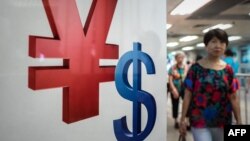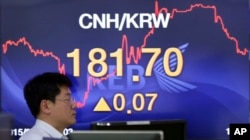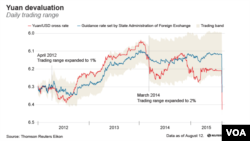China has slightly raised the value of its currency, ending three consecutive days of devaluation that had triggered concerns of an international currency war and raised fresh questions about the health of the world's second-largest economy.
The People's Bank of China on Friday set the yuan's daily reference point at 6.3975 per dollar. That is .05 percent higher than the previous day's midpoint. Beijing strictly controls the yuan within a range of two percent above or below the reference point, which it sets daily.
The move comes after the central bank on Thursday set the yuan's daily reference point about 1 percent lower than the previous day, at about 6.40 per dollar.
Beijing strictly controls the yuan within a range of 2 percent above or below the reference point, which it sets daily.
'Market level'
Bank officials said the yuan was close to trading at "market level" and dismissed as "complete nonsense" rumors that Beijing was ready to let the currency's value fall as much as 10 percent.
Global investors appeared to be reassured by the comments. Stocks were trading higher at opening in Hong Kong and Shanghai, but slightly lower in Tokyo on Friday. Trading on Wall Street held steady on Thursday.
"The adjustment to close the gap between central parity rate and actual trading rate of Chinese currency ... has basically completed," said an official at the People's Bank of China, according to the Xinhua news agency.
Asian markets react
Many investors are worried the intervention signals growth in the world's second-largest economy is slowing more than originally thought.
There are also concerns it could prompt other nations to devalue their currency, since a weaker yuan makes Chinese exports more competitive for foreign buyers.
Vietnam on Wednesday did just that. Under the new rules, Vietnam's currency, the dong, can be traded within two percent above or below the daily reference point. The previous rules allowed trading within 1 percent.
"As China is Vietnam's largest trading partner, an adjustment of Chinese currency will have a negative impact on Vietnam's economy," said the State Bank of Vietnam.
An editorial Thursday in China's state-run Global Times said it was "absurd" to hype the threat of a yuan devaluation, saying there is "hardly" a currency war.
"Since the yuan exchange rate is determined by the market, there are bound to be possible fluctuations in both directions – revaluation and devaluation. And it would be abnormal if it only goes up," the editorial said.
In a VOA interview, Peterson Institute scholar Nicholas Lardy said the change gives Beijing more flexibility in managing the economy.
Lardy said the change also improves the chances China’s currency will play a larger role in international commerce.
Reserve currency
Duke University business professor Campbell Harvey said China wants the yuan to eventually become a “reserve” currency like the dollar and the euro. He said such currencies must be driven by market forces.
Beijing’s change in currency exchange policy brought criticism from several members of the U.S. Congress, who say it continues a practice that gives Chinese exporters an unfair advantage and hurts American jobs.
Exchange rates are among many issues likely to be on the agenda for September’s planned visit to Washington by China’s President Xi Jinping.











